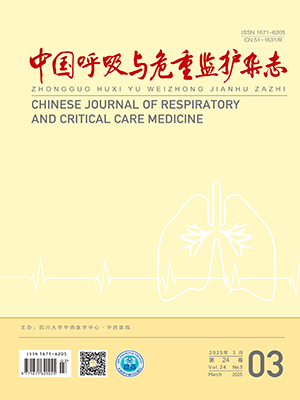Objective To study and compare the effects of inhaled preparations with open airway and conventional inhaled preparation on asthma patients.Methods The patients diagnosed with asthma and treated with the same inhaled preparation only who visited the outpatient department of West China Hospital of Sichuan University, were selected as the study subjects from April to September, 2019. The subjects were divided into the test group and the control group according to random ratio 1∶1. The conventional inhaled preparations were used in the control group. The inhaled preparations with open airway were used in the test group. Asthma control, life quality and treatment satisfaction rate were compared between the two groups after 3 months.Results A total of 150 subjects were included and one case dropped-off, then 149 effective subjects were obtained in which 75 cases in the test group and 74 cases in the control group. After 3 months’ treatment of inhaled preparations, the proportion of effective asthma control patients in the test group was higher than that in the control group, and the number of patients satisfied with the treatment of inhaled preparations was higher than that in the control group, with statistically significant differences (all P<0.05). The life quality of patients in both groups was improved compared with baseline, and the difference was statistically significant (P<0.05). However, the increase of scores in the test group was more than that in the control group, and the difference was also statistically significant (P<0.05). Conclusion Inhaed preparations with open airway is superior to conventional inhaled preparation on asthma patients in asthma control, life quality and treatment satisfaction rate.
Citation:
SUN Lin, WU Xiaoling, MA Wenjuan, LU Haiyan, ZHU Yingying. Comparison of open airway inhalation and conventional inhalation in asthma patients. Chinese Journal of Respiratory and Critical Care Medicine, 2021, 20(5): 335-338. doi: 10.7507/1671-6205.202011057
Copy
Copyright © the editorial department of Chinese Journal of Respiratory and Critical Care Medicine of West China Medical Publisher. All rights reserved
| 1. |
中华医学会呼吸病学分会哮喘学组. 支气管哮喘防治指南(2016 年版). 中华结核和呼吸杂志, 2016, 39(9): 675-687.
|
| 2. |
王刚, 张欣, 王蕾, 等. 轻度支气管哮喘治疗策略的商榷. 中华结核和呼吸杂志, 2018, 41(7): 572-576.
|
| 3. |
中华医学会呼吸病学分会哮喘学组. 支气管哮喘控制的中国专家共识. 中华内科杂志, 2013, 52(5): 440-443.
|
| 4. |
支气管哮喘患者自我管理中国专家共识. 支气管哮喘患者自我管理中国专家共识. 中华结核和呼吸杂志, 2018, 41(3): 171-178.
|
| 5. |
龙虹羽, 林江涛. 哮喘患者的自我管理与哮喘行动计划. 中华医学杂志, 2019, 99(16): 1271-1273.
|
| 6. |
Escobedo MB, Aziz K, Kapadia VS, et al. 2019 American Heart Association Focused Update on Neonatal Resuscitation: An Update to the American Heart Association Guidelines for Cardiopulmonary Resuscitation and Emergency Cardiovascular Care. Circulation, 2019, 140(24): e922-e930.
|
| 7. |
Nathan RA, Sorkness CA, Kosinski M, et al. Development of the asthma control test: a survey for assessing asthma control. J Allergy Clin Immunol, 2004, 113(1): 59-65.
|
| 8. |
王茜, 李晓乾, 叶红, 等. 延续护理模式在支气管哮喘患者中应用的效果. 牡丹江医学院学报, 2015, 36(2): 115-117.
|
| 9. |
Yang MY, Chan JG, Chan HK. Pulmonary drug delivery by powder aerosols. J Controlled Release, 2014, 193: 228-240.
|
| 10. |
薛文东. 影响吸入粉雾剂疗效发挥的因素分析. 中国呼吸与危重监护杂志, 2013, 12(5): 537-540.
|
| 11. |
田沛, 杨志强, 王杏林, 等. 影响干粉吸入剂肺部给药过程的因素. 中国新药杂志, 2015, 24(21): 2459-2466.
|
- 1. 中华医学会呼吸病学分会哮喘学组. 支气管哮喘防治指南(2016 年版). 中华结核和呼吸杂志, 2016, 39(9): 675-687.
- 2. 王刚, 张欣, 王蕾, 等. 轻度支气管哮喘治疗策略的商榷. 中华结核和呼吸杂志, 2018, 41(7): 572-576.
- 3. 中华医学会呼吸病学分会哮喘学组. 支气管哮喘控制的中国专家共识. 中华内科杂志, 2013, 52(5): 440-443.
- 4. 支气管哮喘患者自我管理中国专家共识. 支气管哮喘患者自我管理中国专家共识. 中华结核和呼吸杂志, 2018, 41(3): 171-178.
- 5. 龙虹羽, 林江涛. 哮喘患者的自我管理与哮喘行动计划. 中华医学杂志, 2019, 99(16): 1271-1273.
- 6. Escobedo MB, Aziz K, Kapadia VS, et al. 2019 American Heart Association Focused Update on Neonatal Resuscitation: An Update to the American Heart Association Guidelines for Cardiopulmonary Resuscitation and Emergency Cardiovascular Care. Circulation, 2019, 140(24): e922-e930.
- 7. Nathan RA, Sorkness CA, Kosinski M, et al. Development of the asthma control test: a survey for assessing asthma control. J Allergy Clin Immunol, 2004, 113(1): 59-65.
- 8. 王茜, 李晓乾, 叶红, 等. 延续护理模式在支气管哮喘患者中应用的效果. 牡丹江医学院学报, 2015, 36(2): 115-117.
- 9. Yang MY, Chan JG, Chan HK. Pulmonary drug delivery by powder aerosols. J Controlled Release, 2014, 193: 228-240.
- 10. 薛文东. 影响吸入粉雾剂疗效发挥的因素分析. 中国呼吸与危重监护杂志, 2013, 12(5): 537-540.
- 11. 田沛, 杨志强, 王杏林, 等. 影响干粉吸入剂肺部给药过程的因素. 中国新药杂志, 2015, 24(21): 2459-2466.
Journal type citation(1)
| 1. | 张莹英,安能能,高改娜. 益处引导的行为转变模式对咳嗽变异性哮喘患者的影响. 国际护理学杂志. 2025(04): 641-644 .  Baidu Scholar Baidu Scholar | |
Other types of references(0)





 Baidu Scholar
Baidu Scholar